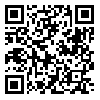Volume 28, Issue 1 (2021)
AIJH 2021, 28(1): 1-22 |
Back to browse issues page
Download citation:
BibTeX | RIS | EndNote | Medlars | ProCite | Reference Manager | RefWorks
Send citation to:



BibTeX | RIS | EndNote | Medlars | ProCite | Reference Manager | RefWorks
Send citation to:
Ghanemi Asle Arabi M, Balavi R, Zare N. Poetic Structure Techniques in Feminine Writings of Nariman Allush. AIJH 2021; 28 (1) :1-22
URL: http://aijh.modares.ac.ir/article-31-41320-en.html
URL: http://aijh.modares.ac.ir/article-31-41320-en.html
1- Arabic Language and Literature, Persian Gulf University, Bushehr
2- Department of Arabic Language and Literature, Persian Gulf University, Bushehr ,r.ballawy@pgu.ac.ir
3- Department of Arabic Language and Literature, Persian Gulf University, Bushehr
2- Department of Arabic Language and Literature, Persian Gulf University, Bushehr ,
3- Department of Arabic Language and Literature, Persian Gulf University, Bushehr
Abstract: (3306 Views)
Lately, we have come across a new model of writing emerged from the feminine criticism. This writing, despite being called differently, became known as feminine writing and is based on different forms and content and seeks to add a feminine identity to literature in order to remove female writers from their isolation and seeks to identify their strengths and innovations to pave the way for reaching phenomenal experiences. In this paper, by studying three poetic collections of Nariman Allush, we have tried reach a conclusion on the poet’s writing style in this research. Using descriptive-analytical method, we seek to highlight the nature of women's writing and reveal the techniques of Nariman Alloush's poetic structure. In this important matter, we have gone beyond men's writing and entered the realm of women's literature, which seeks to legitimize their writing. In the course of our study, we focused on the poet's four-dimensional aspects i.e. her partiality, simplicity, and poetic decoration, and vision that don't exist in the real world and reached to the conclusion that: Nariman Allush's poetry has got a modern taste in structure and similarly she considers partiality and simplicity as the two fundamental aspects in her writing. In the meantime, by using the decor technique, she has revealed the reality of women's lives, especially their position in Eastern societies, as well as examples of misogyny for the audience.
Article Type: مقالات علمی پژوهشی |
Subject:
Arts and Humanities (General)
Received: 2020/03/14 | Accepted: 2020/06/25 | Published: 2021/03/21
Received: 2020/03/14 | Accepted: 2020/06/25 | Published: 2021/03/21
Send email to the article author
| Rights and permissions | |
 |
This work is licensed under a Creative Commons Attribution-NonCommercial 4.0 International License. |







